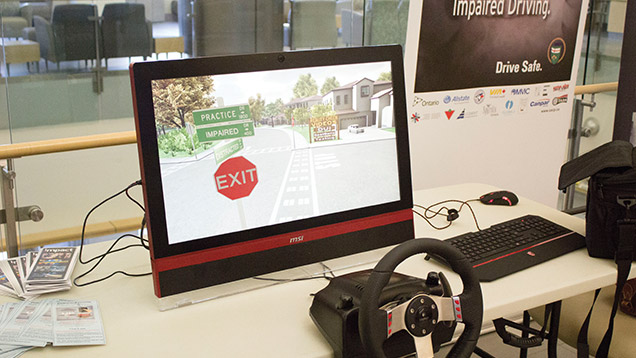Putting locals behind a distracted drivers wheel
 CREDIT: KATE DIGMAN
CREDIT: KATE DIGMANThe simulator allowed visitors and staff at the London Health Sciences Centre (LHSC) become more aware of the effects of distracted driving.
Hospital staff and visitors were encouraged to put their driving skills to the test at the London Health Sciences Centre (LHSC) on August 7.
But this wasn’t your average G test.
As a way to raise awareness for distracted driving, LHSC gave visitors the opportunity to try their new distracted driving simulator with a lifelike computer program. The simulator allows participants to see the effects of various driving distractions, including making a cellphone call and texting.
“Fatalities related to distracted driving in 2013 surpassed alcohol related fatalities on O.P.P. roads, which is really scary,” LHSC Injury Prevention Specialist Brandon Batey said. “We hope that the simulator raises awareness and starts a discussion about distracted driving.”
The simulator, purchased with funds raised during the LHSC’s annual Trauma Golf Classic, takes participants through a practice driving session, followed by a distracted driving simulation, which asks you to use the monitor touch screen to text or call someone.
Various distracted driving consequences are also highlighted during the demonstration, as videos of the courthouse, the hospital and a jail cell appear on the screen.
“I think it’s great to raise awareness, because I don’t think people realize how big of an issue it is to drive distracted,” LHSC Injury Project Associate Tania Haidar said. “Even just a quick glance can put your life or someone else’s life in danger.”
Trauma Program representatives also highlighted Bill 31, which is a recent amendment to the Highway Traffic Act that will increase distracted driving fines from $300 to $1,000 with three demerit points upon conviction.
The bill will be put into effect this fall.
“This bill brings awareness to the seriousness of distracted driving,” Haidar said.
Batey noted that the injuries associated with distracted driving are 100 per cent avoidable and the bill will help bring further attention to the negative impacts of distracted driving.
“I think it’s really important,” he said.
LHSC plans to introduce the simulator to the IMPACT Program, which is presented to over 5,000 secondary school students each year.
Kathy Leblance, LHSC Corporate Communications and Public Relations, says they hope to partner with local university and college staff to promote the simulator and make it available to students.
“Hopefully, in the future, we can do that,” she said.














